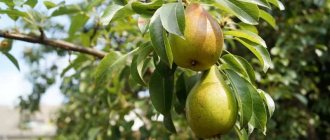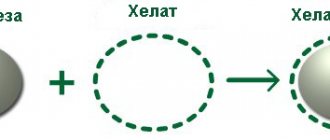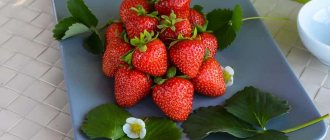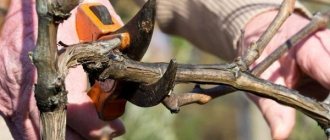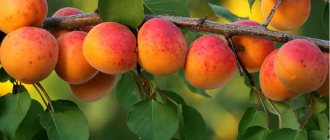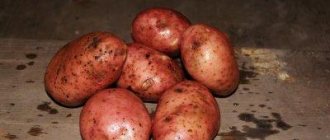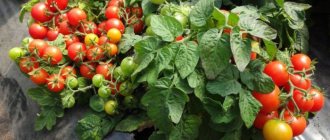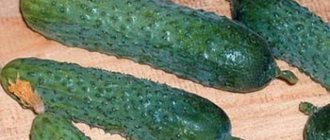How to apply chicken manure to grapes
There are 2 main methods of application - liquid and dry. In liquid form, chicken manure is applied during or immediately after watering; in dry form, it is applied between rows and plowed. Let's look at both methods in more detail.
Application in liquid form
We put bird droppings in a barrel and fill it with water, let it ferment (about 7-10 days), dilute it in a ratio of 1:10 with water and add 1-2 liters. while watering under each bush. Let me remind you about my method of watering - under each bush I made pits with sides made of earth, about 10 cm high, I lay the watering hose in the pit and supply water until it begins to overflow. Feeding with chicken droppings simply accompanies one of the waterings - fill the pit completely with water, pour fermented droppings into the water, and stir with a stick.
Pay attention to the fermentation container - it is better to use a polyethylene barrel rather than a metal one; metal ones rust through very quickly in such an aggressive environment. Also, do not fill the barrel with droppings to the very top; you need to leave space so that during fermentation the contents do not overflow over the edges. Where to place the barrel - in the sun or in the shade, there is not much difference, fermentation will still occur.
Dry application
The second way to introduce chicken manure is into the rows under digging. If you have 2.5-3.0 m between the rows, then add a strip of 1.5-2.0 meters, leaving 50 cm to the head of the bush. You should not place bird droppings directly under the bush; the fertilizer is very concentrated and can burn the roots. Consumption rates - 2 buckets per 1m2. After application, the row spacing is dug up.
Foliar feeding
The vine feeds not only through the roots; many substances enter it through the leaves. This is the reason why foliar feeding of grapes is also recommended in summer. In this case, they use mixtures of all useful microelements, the preparations “Aquarin”, “Plantafol”, “Kemira”, “Florovit”, “Novofet”. Chelate complexes containing all the necessary elements in small doses have proven themselves well.
The vine is also fed with folk remedies. Wood ash (200 g/l) is infused for 2-3 days. Then mixed with a decoction of herbs. It is recommended to add a mixture of minerals to infusions of garlic or tobacco, solutions with copper sulfate or iron, used to combat fungi and parasites.
Foliar feeding of grapes should be done according to a certain scheme 4 times a year:
- The bushes are treated for the first time 3-5 days before the flowers open. A mixture of boric acid with fungicides or iron is used to prevent diseases and stimulate the formation of berries. It is also recommended to feed the vine with nitrogenous agents.
- The second time the treatment is carried out 5-10 days after the start of flowering. Compositions with phosphorus or ash are used, nitrogen is excluded.
- The vine is treated for the third time in July, 2 weeks after the second, with a similar composition.
- The last foliar feeding is carried out 15 days before the final ripening of the berries. Potassium and complex potassium-phosphorus fertilizers are used for grapes. With their help, they accelerate the ripening of berries, improve their taste, and prepare the vine for winter.
Only liquid products are used. They are poured into a sprayer and the lower surface of the leaves is irrigated. This is where the stomata are located, through which minerals penetrate into the plant. If you don’t have a sprayer, soak a cloth in the solution and gently wipe the bottom surface of the leaf. It is recommended to apply grape fertilizer to the leaves early in the morning or in the evening, after sunset, otherwise the leaves will get burned.
Fertilizer and feeding of grapes
Fertilizer that makes grapes grow like scalded ones
FEEDING GRAPES IN SUMMER FOR A GOOD HARVEST
In addition to root feeding, in spring and early summer, foliar feeding of grapes is very useful. The most effective treatment is with nitrogen fertilizers and solutions of microelement salts (boron, zinc, molybdenum, sulfur).
These treatments strengthen the vitality of the grapes and increase the crop's resistance to disease. They are carried out before flowering, as well as during the period of fruit set and active growth. The concentration of nitrogen fertilizers (ammonium nitrate, urea, azophosphate) should not exceed 0.3–0.4%, potassium fertilizers (potassium sulfate) - 0.6%. It is very convenient and rational to use ready-made mixtures for spraying:
- Ovary,
- Plantafol,
- Aquamarine,
- Kemera,
- Novofert.
The solution for processing grapes is prepared in strict accordance with the instructions. Spraying should be done in calm weather, preferably in the evening (after 18 o'clock) or early in the morning (before 9 o'clock).
When to feed grapes with chicken manure
Application in liquid form
In the phase “the end of flowering and before the berries begin to fill,” the rate of nitrogen absorption through the root system reaches its maximum, and at this time it is necessary to feed. If the grapes have bloomed, we fed them with bird droppings; we don’t add any more nitrogen, otherwise there may be problems with the ripening of the vine and fattening of the shoots. We feed the grapes with bird droppings only once per season!
Dry application
In dry form, it is best to apply chicken manure in late autumn; you can immediately walk through it with a walk-behind tractor and mill it, or dig up the rows in the spring.
Pros and cons of using chicken manure on grapes
Minuses
- stink, even if this is not a particularly literary word, but the synonyms simply do not fit, chicken droppings stink, and after working with it, your things also stink;
- a large number of flies, if we introduce chicken manure into the aisles, then it is better to mill the manure immediately; if we put chicken manure for fermentation, then it is better to cover the barrel with gauze or use old tulle;
- There are concerns that the food used to feed poultry may contain antibiotics, but these are only concerns; the information has not been confirmed by anyone.
pros
- depends on the area, but in Bashkiria, chicken manure costs 1.5 times cheaper than horse or cow manure;
- high nitrogen concentration;
- there are a lot of weed seeds in horse and cow manure, but there are none in chicken droppings;
- Many people keep poultry in their dachas during the summer; you may not even have to purchase a litter.
Alternative Ways to Use Chicken Manure
We looked at 2 ways to apply chicken manure to the vineyard: in dry form for autumn digging and in liquid form at the root after flowering, there are other methods that have not been personally tested by the author, but are found on the forum:
- do not add chicken manure in its pure form, but first put it in compost heaps along with organic residues and grass, and then feed the vineyard with ready-made compost;
- take a plastic five-liter container, cut it in half, fill it with chicken droppings and place it next to the bush so that the plastic is on top and the droppings are in the ground, gradually the soil biota will process the droppings, and the plastic will protect from the smell and flies;
- take 2 bags of sugar, remove the plastic inner layer from them, put one bag into the other, pour chicken manure into a double bag and place the bag in a barrel of water, let it ferment for 10 days, then use it for drip irrigation of grapes. The process is similar to brewing tea using a tea bag;
- It is also possible to introduce pigeon manure rather than chicken manure, but there is a risk of becoming infected with Ornithosis, pigeons are dirty birds that shit in the nest, resulting in a whole breeding ground for microbes.
Root feeding with mineral fertilizers
This question often arises among gardeners.
In fact, for normal growth, full development and abundant harvest, grapes require both mineral and organic fertilizers. Their complex application should be done in strict proportions and in a timely manner. For a fruitful vineyard, it is necessary to replenish the following elements contained in both organic and inorganic fertilizers:
- Nitrogen. Adding it to the soil in the fall promotes normal growth and development of green shoots in spring and summer. By autumn, the need for it in plants decreases. Nitrogen is found in large quantities in ammonium nitrate and urea.
- Potassium. This element allows the vine to overwinter more effectively and promotes its rapid ripening.
- Phosphorus. It is necessary for abundant flowering and fruit formation. Prevents ovaries from shedding. It is applied mainly in the form of superphosphate.
- Zinc. A lack of zinc in the soil leads to a decrease in fruit size and reduced vine yield.
- Copper. It helps increase disease resistance, drought resistance and frost resistance.
- Bor. Due to sufficient boron content in the soil, more ovaries are formed, as it affects the development of pollen. Boron also increases the sugar content in fruits, improving their taste.
Let's take a closer look at each type of fertilizer for grapevines.
The following can be used as mineral fertilizers:
- superphosphate,
- potassium salt,
- boric acid,
- urea,
- manganese sulfate,
- zinc sulfate,
- ammonium molybdate,
- potassium iodine,
- ash.
Single-component mineral fertilizers can be replaced with complex ones, which will give the plant all the necessary nutrients.
Such fertilizers include:
- Kemira,
- Florovit,
- Mortar,
- Novofert,
- Aquarin,
- and others.
Ash fertilization
Manure is an ideal fertilizer for grapes, as it is rich in potassium, nitrogen and phosphorus. Thanks to it, the soil becomes lighter, which increases its breathability and water permeability. The microflora also improves, which contributes to better absorption of all necessary substances by the plant.
In the absence of manure, compost can be used. It is prepared from organic waste, grass and ash. Compost has the same properties as manure, but care must be taken to ensure that any plant debris added to it is not contaminated with diseases or parasites. Otherwise, its addition will more likely harm the plant than help.
Chicken manure, along with manure, is the most preferred fertilizer for grapes, as it contains large quantities of potassium, magnesium, phosphorus, and nitrogen.
But it must be diluted, because concentrated chicken droppings can harm the plant. It is diluted in water in a ratio of 1 liter of litter to 4 liters of water, then after a week more water is added, bringing the resulting volume to 10 liters. Then add it to the soil at the rate of 0.5-1 liter per plant.
Diluted chicken manure
The vine is a capricious plant that needs care. One of the activities that farmers often ignore is the correct application of fertilizers. They consist of a number of microelements necessary for growth, ripening of berries, and protection from diseases.
Minerals needed by the vine:
- Nitrogen. It stimulates the growth of stems and leaves, increases the green mass of the bush. Nitrogen fertilizers are beneficial for grapes in spring and early summer. They cannot be brought in in the fall, because the vine will weaken and freeze in winter.
- Phosphorus. It promotes the formation of flowers and fruits, makes berries tasty, and accelerates their ripening. It is recommended to apply it before the formation of inflorescences and 10-15 days before harvesting the bunches.
- Potassium. It accelerates the ripening of the vine, making it more resistant to drought, frost, parasites and diseases. Bushes should be fed with potassium mixtures in the fall and late summer to prepare the seedlings for wintering.
- Bor. It improves pollen germination, counteracts the fall of ovaries, accelerates the ripening of bunches and makes them sweeter. Boron is applied before the end of flowering or when the ovaries begin to form.
- Copper. It stimulates the development and growth of young shoots, increases frost and drought resistance, and improves immunity.
- Zinc. It increases productivity.
- Magnesium. This element promotes better absorption of phosphorus, takes part in protein synthesis, and improves the taste of berries.
To ensure that the bushes receive the entire set of minerals, complex ready-made fertilizers for grapes and organic matter are applied. It is also recommended to feed the vine with monopreparations. For example, urea, ammonium nitrate, monophosphate.
Ready-made fertilizers for grapes can be purchased at the store or prepared independently.
It is recommended to feed grapes with a complex preparation in the spring to add all the necessary mineral elements to the soil. Names of popular complex drugs:
- "Kemira";
- "Plantafol";
- "Florovit";
- "Solution."
Some farmers prefer to prepare the mixtures themselves. Popular recipe for use in spring (per 10 liters of water):
- superphosphate - 20 g;
- ammonium nitrate - 10 g;
- potassium salt - 5 g.
The mixture is enough for one bush. Instead of superphosphate and nitrate, nitroammophoska in a dose of 30 g is often used. They are also replaced with azophoska in a similar amount.
Another useful recipe:
- potassium magnesia - 10 g;
- ammonium nitrate - 20 g;
- boric acid;
- water - 10 l.
This fertilizer for grapes is used in the last days of spring, when intensive growth of the crown and branches is observed. During the period of ovary formation, the bushes are watered with superphosphate, and in the fall - with potassium fertilizers.
In autumn it is recommended to use the following mineral complex:
- potassium salt - 10 g;
- superphosphate granules - 20 g;
- boric acid - 1 g;
- zinc sulfate - 2 g;
- manganese sulfate - 2 g;
- Potassium iodide - 1 g.
Dilute the salt mixture in 10 liters of water. This is a dose for 1 bush.
Organic-based fertilizers are completely natural and therefore are considered environmentally friendly and the most beneficial for grapes. However, not all owners of summer cottages can purchase manure or bird droppings. And the amount of basic macro- and microelements in such feeding is sometimes not enough to fully nourish the bushes.
Fertilizing with mineral fertilizers should be combined with watering the grapes; one bush requires 3-4 buckets of clean warm water. Fertilizers containing nitrogen and potassium are usually highly soluble in water, so they are mainly used for liquid feeding. Superphosphate, due to the presence of gypsum in its composition, is a sparingly soluble mixture.
